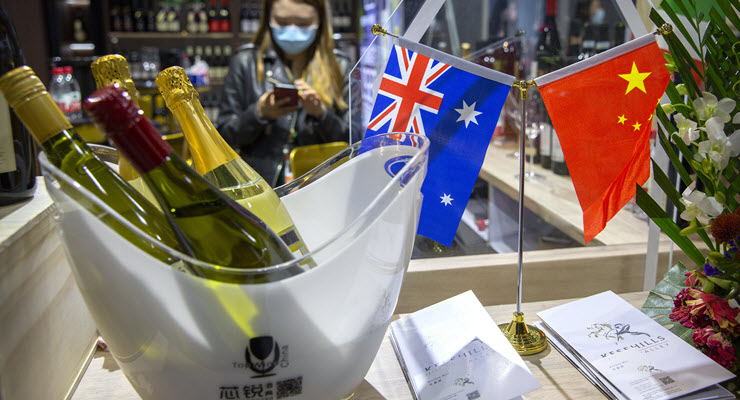
Can Australia break its dependence on trade with China? There are precedents. Not all of them are hopeful.
Australia has had a single dominant trading partner before. We were locked into the UK economy first and then, much later, to Japan.
As the chart shows, China’s outsized relevance to our national wealth is not without precedent. Japan had a similarly big role in the 1970s and before that the UK was even more dominant.

Might we be able to engineer changes that make China fade in our trade statistics? After all, trade relationships are not immutable. If Chinese babies aren’t drinking Australian infant formula, other babies will. If Australian wine is not being served at Chinese tables, there are places where it will be.
Perhaps.
However, when you look more closely at that graph two major observations must be made.
First, the changes in our trade relationships were made neither quickly nor by political whim. Instead they corresponded with the rise and fall of great powers.
The UK was the world’s biggest power up until World War II. It faded in global dominance thereafter and as an Australian trade partner. As it fell, Japan rose. The “postwar miracle” saw its economy surge, growing at a mind-blowing rate for several decades. Those are the decades during which it also comes to feature heavily in Australia’s trade statistics.
Second, the changes did not happen fast. Indeed, Japan remains our second biggest trading partner, and the UK is our eighth.
These two facts force us to consider our trade with China in a cold light.
It seems likely China will continue to grow. Precisely when it becomes the world’s largest economy is unclear. Some say it has already happened. If not, it will during the next few years. China’s performance in keeping the pandemic under control will only speed the process of overtaking the West.

China’s economic potential is vast because its population is vast, and it can be expected to “catch up” to the economic frontier, like Japan and South Korea before it.
Catch-up growth — by adopting modern technology and building infrastructure etc — can be much faster than growth in advanced countries that have technology and infrastructure in place. If China simply catches up to the per capita GDP level of South Korea it can triple its economic heft. In so doing, it would be three times the size America is now.
In a recent book, American commentator Matthew Yglesias argues the US should treble its population to 1 billion to avoid being outcompeted by China and maintain US hegemony.
Now I’m amused by the idea of an arms race that strips the term of its metaphorical aspect and involves racing to produce more actual arms (and legs, etc). But the idea seems impractical. Similar thinking appears in more dilute (and more realistic) form when Australian policymakers call for a larger Australian population. Either way the lesson is the same: power depends on size. And China has size to spare.
Population size is a race in which China is not even competing. It has hobbled itself with a one-child policy. Its remarkable economic growth has been achieved without much population growth (unlike Australia). If China should decide to turn demographics in its favour and increase its population, it could grow even larger and more powerful.
So China is getting stronger, which suggests reducing our trade with it is an unlikely prospect. Can we make that a good thing — not a risk?
As long as China’s economy is growing, it will need steel. Perhaps not as much as before (as the next graph shows, steel intensity of GDP is usually highest when countries are in the earlier phases of growing rich) but still a great amount. And that will have it looking at Australia.

Economic links create strong person-to-person and business-to-business ties. They make both sides better off. They also raise the cost of conflict.
The conflict between Australia and China is very much top-down. It is not a popular uprising by the Chinese against Australia but a policy choice by President Xi Jinping. (His strong man tactics against Australia mirrors those of Donald Trump against China.) Prime Minister Scott Morrison has chosen to wade in.
These choices can be reversed, and indeed may be in the more stable global environment of a Biden administration. This is the hopeful outlook. But it is not the only one.
Examining Australia’s trade statistics for the past 150 years, looking for times when our trade relationships reduced, I found two other precedents. During the 20th century there were two episodes where a trade partner rapidly grew in importance then shrank to zero. These periods were, as the next chart shows, 1914-18 and 1939-45.

Look closely at the chart, and you can see that the trade relationships actually falter before the giant global wars start.
Is the drumbeat of tension between Australia and China the introduction to a larger conflict between China and the West? It is not without precedent. It took about a century to pay the price for forgetting the lessons of the Spanish flu.
Has it been so long since World War II that we’ve forgotten the importance of maintaining peace?








Crikey is committed to hosting lively discussions. Help us keep the conversation useful, interesting and welcoming. We aim to publish comments quickly in the interest of promoting robust conversation, but we’re a small team and we deploy filters to protect against legal risk. Occasionally your comment may be held up while we review, but we’re working as fast as we can to keep the conversation rolling.
The Crikey comment section is members-only content. Please subscribe to leave a comment.
The Crikey comment section is members-only content. Please login to leave a comment.